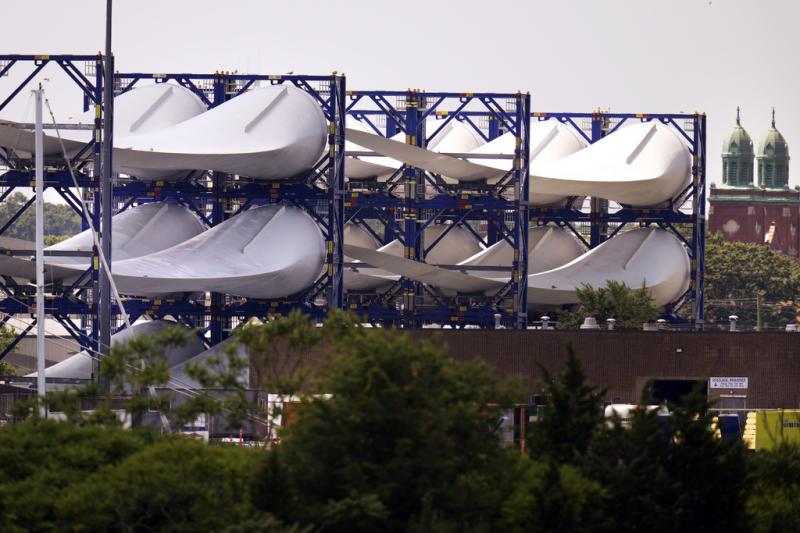A 'clean energy' disaster looms off our coasts
By: Paul Driessen, Opinion Contributor (The Hill)


An ocean environment is not conducive to long-term reliability. While pundits like to point to hurricanes and storms as risks for offshore wind, do not discount the more common weather phenomena of gusting winds, thrown spray, and icing. The greatest risk for wind turbines, particularly horizontal axis turbines, are imbalances that cause uneven stresses. Horizontal axis wind turbines are prone to shaking themselves apart if an imbalance develops.
Real world experience coupled with experimental testing has shown that vertical axis turbines possess several advantages over the more common horizontal axis turbines for offshore use.

Photos of oil-covered seals and birds from California's 1969 Santa Barbara blowout helped launch the environmental and stop-oil movements. More recently, the 2010 Deepwater Horizon drillship disaster killed 11 workers and blasted 3-4 million barrels of oil and enormous amounts of natural gas into the Gulf of Mexico.
These accidents spurred industry to implement better blowout-prevention technologies and procedures.
Such industry actions, of course, never placated environmentalists who wanted them banned forever. But now the question is whether they will apply the same standards for wind energy today.
A recent mishap off the coast of Nantucket, an island in Massachusetts, underscores yet another reason why hundreds or thousands of monstrous wind turbines should not be permitted in America's coastal waters. Shards, chunks and finally the rest of a turbine blade fell into the ocean. One blade … from a 62-turbine project that is only three-fourths completed.
The blade was broken by its own weight, not even by a storm. And yet it was enough to force the closure of beaches amid peak tourist season, while crews picked up pieces of fiberglass-resin-plastic-foam. Boats were also forced to dodge big pieces floating in the water. Worse, Vineyard Wind, the company behind the project, didn't even warn Nantucket officials about the problems until two days after the blade began disintegrating.
Each blade is 350 feet long and weighs 140,000 pounds. That's more than a fully occupied Boeing 737 jetliner. The Vineyard Wind project involves 186 blades, or 65,000 feet (12 miles) in total combined length and a combined 26,000,000 pounds in weight.
The Biden-Harris offshore wind plan calls for 30,000 megawatts of generating capacity by 2030. That would require 2,500 gigantic 12-megawatt offshore turbines. Offshore wind's contribution toward meeting future demands for all Atlantic Coast states could easily require 5,000 such turbines. That means 15,000 blades, weighing a combined 2 billion pounds and spanning a combined 5,250,000 feet (995 miles).
That's a lot of potential ocean-bound junk.
Every year, the entire Atlantic coastline is hurricane country. The only questions are how many hurricanes, how powerful and where each one will hit. The National Oceanic and Atmospheric Administration records for landfalling hurricanes — those that actually hit U.S. beaches and cities — reveal that 105 Category 1-5 hurricanes struck the Atlantic seaboard, from Florida to Maine, from 1851 through 2023. Add in those that remained at sea, where the turbines will be, and that number could double.
Of that total, 23 were Category 3 through 5, meaning their winds were 111 miles per hour or more. Most struck Florida, Georgia and South Carolina, but 39 made landfall between North Carolina and Delaware. Nineteen hit Northeastern states, including nine Category 2-3 monsters (96 to 129 mph winds).
Mind you, these turbines will be weakened by constant corrosive salt spray and frequently by sub-hurricane storms. When the inevitable big hurricane roars up the coast, devastation will follow.
Kamala Harris is bullish about offshore wind. For the last three-and-a-half years, she has helped run an administration that's determined to convert the nation to wind, solar and battery power, expedite permits for onshore and offshore "clean energy" projects and even waive requirements that offshore wind developers post bonds and pay for removing damaged, broken and obsolete offshore wind towers. She supports banning plastic straws, but has she ever considered how many plastic straws it would take to equal 15,000 offshore wind turbine blades?
Harris, Minnesota Gov. Tim Walz (D) and other wind advocates dismiss worries about hurricanes as anti-wind-energy fearmongering. Yet history says otherwise.
The 1935 Labor Day Hurricane clobbered Florida with 200-plus mile-per-hour devastation and Georgia with Category 1 winds. The Great New England Hurricane of 1938 smashed into New York, Connecticut, Rhode Island and Massachusetts with 115-120 mph force. The Great Atlantic Hurricane of 1944 — punished the coast from North Carolina to New Jersey and Massachusetts with Category 2 winds.
Hurricane Edna hit the Northeast with Category 2 winds in 1954, Donna did it again in 1960 and Gloria clobbered the region with 96-115 mph blasts in 1985, even reaching New Hampshire and Maine. Isabel hit North Carolina and Virginia in 2003. The "minor" Category 1 hurricane of 2012, better known as Superstorm Sandy, was also devastating.
This is just a sample of the kind of weather that will hit our planned forests of offshore turbines. Whether they are fixed to the seafloor or sitting atop enormous floating platforms, the likelihood approaches 100 percent over time of a massive failure that makes this summer's trouble in Nantucket seem mild by comparison.
Replacing hundreds or thousands of torn, damaged and smashed turbines and blades could take years, perhaps decades, to say nothing of the cleanup process or environmental damage.
Before we rush further into this "renewable energy transformation," can we first have some realistic, commonsense analysis?
Paul Driessen is senior policy analyst for the Committee For A Constructive Tomorrow and author of books and articles on energy, environment, climate and human rights issues.



Throwing boatloads of taxpayer money at green-washing big corporations may score political points and be ideologically satisfying. But history has shown that boondoggle projects advocated by political scientists typically create as many problems as they try to address. Over time we end up with the same nagging problem along with a lot of new problems created by government activism.
Yea I am sure this is much worse for the environment than over 3 million barrels of oil being dumped in the gulf.
How did the Deep Horizon blow out and spill impact the beaches in Massachusetts? The NIMBY crowd might be disappointed with the imposed fix of wind turbines. Best not to ask them until it's too late.
The point being that wind energy is BY FAR cleaner than fossil fuels, it's not even a debate.
Very true, that's why all such wind systems require petroleum fueled backup generators,
That's fine, except the point of the seeded opinion and your comment highlighting Deep Horizon was about coastal pollution and degradation beaches and riparian environments. And my point is that the NIMBY environmentalists are more concerned with their own backyards than with cleaner energy.
The cleanest energy, BY FAR, is the energy that is not consumed. True conservation beats all the high-tech solutions; it's not even a debate.
Nuclear power plants are designed to operate 24/7 without need for backup generators or energy storage.
Everything you both wanted and didn't want to know about Paul Driessen:
The biggest problem is that any real problems are decades away from happening. Storms are not getting stronger or more frequent or dumping larger amounts of rain...such event are simply being observed and reported more because of all the hysteria about climate change. The oceans are still rising only about a tenth of an inch a year.
Gas fueled cars are not going away anytime soon, whether here in the US or worldwide. EV's are not selling well, and will likely never dominate the market. Commercial trucks, heavy and farm equipment, railroad locomotives, military and commercial aircraft, and military and commercial ships will continue to use petroleum fuels for the foreseeable future.
Any wind and solar power must still be tied into the existing grids and require petroleum fueled backups